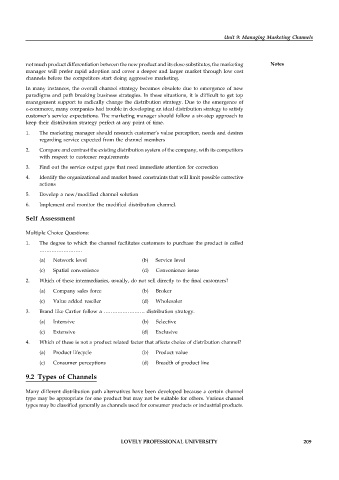Page 216 - DMGT408DMGT203_Marketing Management
P. 216
Unit 9: Managing Marketing Channels
not much product differentiation between the new product and its close substitutes, the marketing Notes
manager will prefer rapid adoption and cover a deeper and larger market through low cost
channels before the competitors start doing aggressive marketing.
In many instances, the overall channel strategy becomes obsolete due to emergence of new
paradigms and path breaking business strategies. In these situations, it is difficult to get top
management support to radically change the distribution strategy. Due to the emergence of
e-commerce, many companies had trouble in developing an ideal distribution strategy to satisfy
customer’s service expectations. The marketing manager should follow a six-step approach to
keep their distribution strategy perfect at any point of time.
1. The marketing manager should research customer’s value perception, needs and desires
regarding service expected from the channel members
2. Compare and contrast the existing distribution system of the company, with its competitors
with respect to customer requirements
3. Find out the service output gaps that need immediate attention for correction
4. Identify the organizational and market based constraints that will limit possible corrective
actions
5. Develop a new/modified channel solution
6. Implement and monitor the modified distribution channel.
Self Assessment
Multiple Choice Questions:
1. The degree to which the channel facilitates customers to purchase the product is called
…………………….
(a) Network level (b) Service level
(c) Spatial convenience (d) Convenience issue
2. Which of these intermediaries, usually, do not sell directly to the final customers?
(a) Company sales force (b) Broker
(c) Value added reseller (d) Wholesaler
3. Brand like Cartier follow a …………………… distribution strategy.
(a) Intensive (b) Selective
(c) Extensive (d) Exclusive
4. Which of these is not a product related factor that affects choice of distribution channel?
(a) Product lifecycle (b) Product value
(c) Consumer perceptions (d) Breadth of product line
9.2 Types of Channels
Many different distribution path alternatives have been developed because a certain channel
type may be appropriate for one product but may not be suitable for others. Various channel
types may be classified generally as channels used for consumer products or industrial products.
LOVELY PROFESSIONAL UNIVERSITY 209

